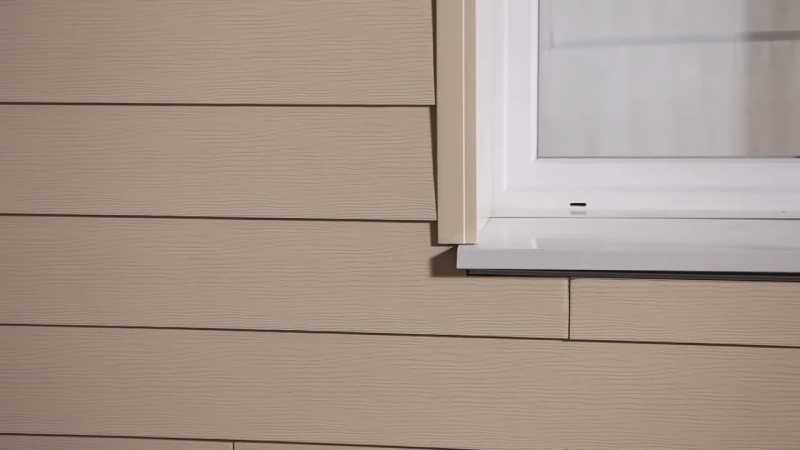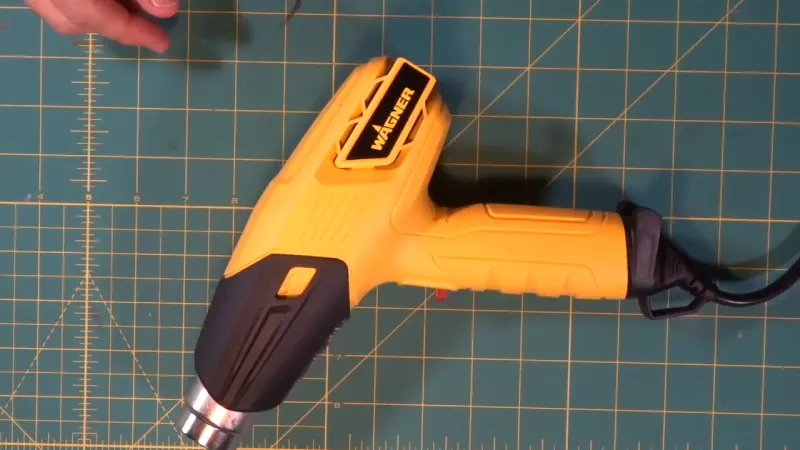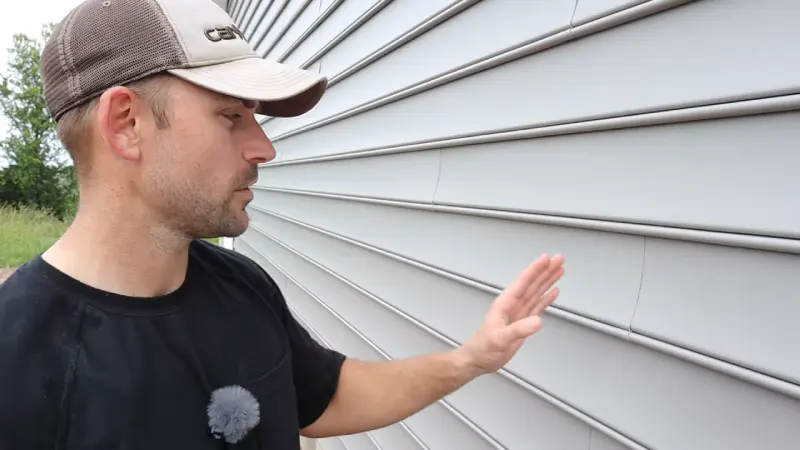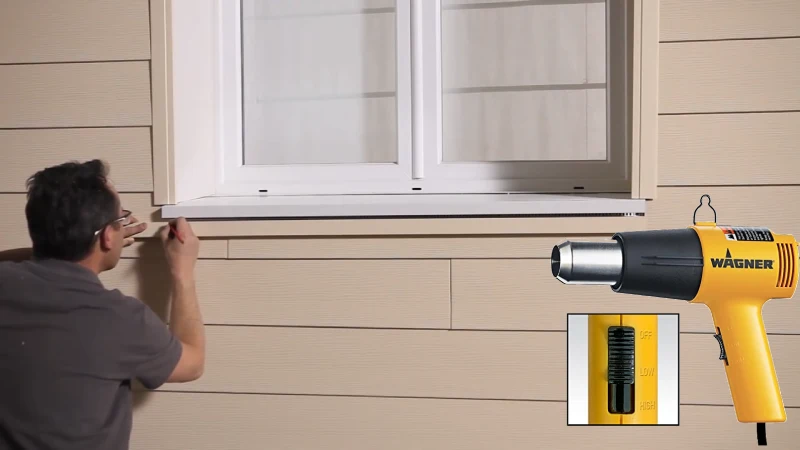Can You Use a Heat Gun on Vinyl Cladding: 7 Reasons [For Safety]
TheToolGeeks.com is a participant in the Amazon Services LLC Associates Program and other affiliate advertising programs. We may earn from qualifying purchases. (Learn More).
A heat gun might seem the simplest and fastest way to repair or remove vinyl cladding, but it could deteriorate it instead. Despite being made from plastic resin known as polyvinyl chloride (PVC), vinyl cladding could warp, melt, discolor, and even have warranties not honored if excessively heated.
To maintain the top condition of your siding and keep any warranties in place, specialized tools are available to do the job effectively without risking any damage. A few of them include hot water, a hair dryer, a heat lamp, and so on.
The purpose of this article is to explain briefly why using a heat gun is not advised. We will also discuss what better alternatives are available, along with what temperatures become too dangerous for vinyl siding or cladding.
Jump To Page Contents:
Can You Use a Heat Gun on Vinyl Cladding: Why Not?

The use of a heat gun on vinyl cladding is highly discouraged for a variety of reasons. Here are some reasons why you should avoid using a heat gun on vinyl cladding:
01: Discoloration
When using a heat gun on vinyl siding, the intense heat can cause the plastic to expand and contract at different rates.
This uneven expansion and contraction can lead to an uneven finish, making the vinyl look dull or patchy due to the discoloration resulting from the heat. And it may also cause colors to fade, making them appear washed out or faded.
02: Warping
Heat guns also pose a risk of warping when used on vinyl cladding. As the plastic expands and contracts at different rates due to the heat applied by a heat gun, areas exposed to higher temperatures are more likely to vinyl wrap than those exposed to lower temperatures.
This can create an uneven or distorted look which is undesirable for many vinyl cladding applications.
03: Melting
The intense heat emitted by a heat gun can easily cause soft PVC resins used in some forms of vinyl cladding to melt and leave behind charred or melted spots on its surface.
Not only does this ruin the appearance of the cladding, but it also renders it useless for its intended purpose, as water or other debris can easily seep into these melted spots creating further damage over time.
04: Protective Coating Stripping
Using a heat gun on vinyl siding can strip away any protective coatings present on it, leaving it vulnerable to damage from water, dirt, and other debris which could result in microbial growth, mold formation, and even structural integrity issues down the line if not addressed in time.
Therefore, all protective coatings must be kept intact when dealing with vinyl cladding to ensure maximum protection against external elements for prolonged periods.
05: Degradation of Resins
Using a heat gun on vinyl cladding can lead to the degradation of PVC resins used in the material, causing them to become brittle or weak over time. The high temperatures generated by a heat gun can break down the molecular structure of these resins and reduce their performance.
This can lead to cracks, warping and other forms of damage that may not be evident until it is too late. Also, when exposed to such high temperatures, these resins may also release harmful toxins into the surrounding environment, which can be dangerous if inhaled.
06: Warranty Voiding
Another reason you should not use a heat gun on vinyl siding is that most manufacturers will void any warranties in place with their product if you do so.
Any issues arising after using a heat gun will not be covered by the manufacturer, leaving you open to costly repairs or replacement costs.
07: Unprofessional Appearance
Finally, using a heat gun on vinyl cladding can leave behind an unprofessional-looking finish due to discoloration, warping, or melting during the application.
This could give off the wrong impression and potentially damage your reputation as a professional or experienced tradesman capable of high-quality workmanship.
Also, this sort of damage may affect the structural integrity of your project and potentially lead to long-term issues such as water infiltration or air leakage.
Can a Heat Gun Be Used On Vinyl Cladding at a Low Heat Setting?

Using a heat gun at a low temperature on vinyl cladding is possible but should be done cautiously. Heat guns typically emit temperatures of 200°F to 1000°F or higher, which can easily damage most types of vinyl cladding and cause it to melt or become discolored.
Therefore, ensuring that the heat gun is set to a low temperature, no more than 100°F, and keeping an appropriate distance from the cladding while in use is crucial. Testing the heat gun on a small, inconspicuous area first and following the manufacturer’s instructions and safety guidelines is also recommended.
Various methods can be employed to shape the material when using a heat gun on a vinyl siding at a low-temperature setting. For example, one popular method is to apply gentle pressure to the outer edges of the fabric while heating it with the heat gun to bend and shape them into the desired form.
Another method involves using scrap pieces of wood as backing supports for larger sheets of vinyl cladding. The scrap pieces help keep the vinyl in place while allowing it to be heated up and reshaped.
In fact, heat guns are more effective on metal siding, wood siding, fiber cement siding, and aluminum siding panels.
What Are the Alternatives to Heat Guns for Working with Vinyl Cladding?
Instead of using a heat gun, several other tools and techniques can help you remove or repair vinyl cladding without worrying about damage. Some of the alternatives include:
i) Hot Water can be used to soften and shape vinyl cladding in many cases, allowing it to be manipulated into place. It is essential to ensure the water temperature is not too hot, as this can cause damage to the vinyl material and its adhesives, leading to an inferior finished product.
ii) Hair Dryer is another viable alternative for vinyl siding. A hairdryer can help to soften and shape the material enough so that it can be manipulated into its desired shape without excessive force or damage being done to it.
iii) Heat Lamps are useful when working with vinyl cladding as they provide localized and targeted heat which helps soften and shape the material in a safe and controlled manner.
iv) Adhesive Patches or Replacement Pieces can be used when working with vinyl cladding rather than using heat guns alone. But, they require some skill on behalf of the user for them to be successfully applied correctly without damaging the material itself or surrounding areas.
Many professionals prefer this method due to its reliability, quick installation time, and ability to make precise modifications without worrying about potential damage from excessive heat exposure from heat guns.
v) Hand Tools like screwdrivers, pliers, utility knives, rulers, and chisels can help when you’re shaping something. You can use them with either hot water or a hair dryer to ensure the shape is right without using too much heat from a heat gun. But they may not be good enough for big projects.
vi) Caulking and Nail Guns are the preferred tools of many professionals in specific time-sensitive projects such as vinyl cladding installations. The advantage of using these automated tools is that they provide much quicker application times without compromising accuracy or quality.
At What Temperature Does Vinyl Cladding Crack?

Vinyl cladding is made from polyvinyl chloride (PVC), with a softening point of approximately 100°F and a melting point of 160°F to 165°F. Therefore, any temperature above 100°F can damage the vinyl cladding and may crack or become distorted at temperatures higher than 165°F.
This means that using a heat gun with temperatures greater than 100°F should be avoided when working with vinyl cladding, as it is likely to cause damage and cracking.
And the temperature setting of most heat guns can reach up to 1000°F or more, making them unsuitable for working with vinyl cladding.
The temperature range for most heat guns starts at 200°F and goes beyond 1000°F, making them too powerful for working with vinyl cladding which can easily crack under too much heat.
Therefore, it is best to avoid using a heat gun on vinyl cladding and instead use other methods, such as a blow/hair dryer set on low or warm settings or an iron set on low settings if needed.
Avoid Using Heat Guns on Vinyl Cladding to Prevent Defects
While you may be tempted to use a heat gun on vinyl cladding for quick removal or repairs, it would be wise to avoid this method as it can lead to bad outcomes such as warping, melting, and discoloration of the material. Also, using a heat gun could potentially nullify any manufacturer warranties.
Hot water, hair dryers, or heat lamps are better alternatives to heat guns for removing vinyl siding or cladding. With these alternatives, you can safely remove the material without damaging it or exposing it to high temperatures, which could harm it.
By understanding your options and taking appropriate safety measures when handling vinyl cladding, you can ensure your project runs smoothly with no significant complications.
Amazon and the Amazon logo are trademarks of Amazon.com, Inc, or its affiliates.

